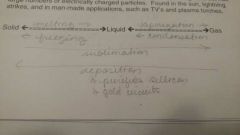![]()
![]()
![]()
Use LEFT and RIGHT arrow keys to navigate between flashcards;
Use UP and DOWN arrow keys to flip the card;
H to show hint;
A reads text to speech;
47 Cards in this Set
- Front
- Back
- 3rd side (hint)
|
Matter |
Anything that has mass and occupies space |
|
|
|
Mass |
The quantity of matter with in an object. It is distinct for weight, as is does not change according to gravity. |
|
|
|
Energy |
That capacity to do Work (W=F/d) |
|
|
|
Chemistry |
The study of composition, properties and interactions of matter |
|
|
|
Pure substance |
Constant composition, cannot be separated into simpler substances Example (in hint) |
CO |
|
|
Physical process |
Process in which a substance does not undergo a change in composition or chemical properties |
|
|
|
Mixtures |
Made up of two or more substances mixed together. |
|
|
|
Homogeneous mixture/solution |
Have same composition throughout |
Examples: air, salt, water |
|
|
Heterogeneous mixture/solution |
Have composition which is different from place to place in the same sample |
Water with ice cubes |
|
|
Elements |
Simplest building blocks of matter |
|
|
|
Compound |
Chemical combinations of two or more different types of elements Example (in hint) |
NaCl, KF |
|
|
Compounds can be separated through a |
Chemical reaction |
CH4 + 2O2 -> CO2 + 2H2O + heat |
|
|
Law of constant composition |
Elements in compounds are always present in definite proportions |
Joseph Proust |
|
|
Atom |
The smallest particle of an element that can enter into a chemical combination |
Dalton |
|
|
Molecule |
Two or more atoms held together by chemical bonds |
|
|
|
Chemical formula |
Consists of the symbols of the elements and subscripts indicating the number of each type of element in a molecule. |
|
|
|
Chemical equation |
The language of chemistry seen in the symbols used to explain the shorthand used to describe chemical and physical processes |
|
|
|
1 Mole = |
6.022 x 1^23 atoms of Element |
|
|
|
moles in 12 g pure C? Atoms? |
1 mole C= 6.022x 10^23 C atoms = ?g C |
|
|
|
Decantation |
Mixtures can be separated by pouring off one layer, leave the other behind |
|
|
|
Distillation |
The more volatile (easily vaporized) substance is boiled away first |
|
|
|
Filtration |
A mixture of a solid in a liquid is poured through a filter to trap solid |
|
|
|
Chromotography |
Used to separate and identify substances in a mixture |
Types: paper, thin-layer, gas |
|
|
Intensive |
Properties are independent of the amount of substance. |
Ex) Mallible, Shiney, conductive, solid |
|
|
Extensive |
Properties depend on the amount of the substance in sample |
Ex) weight, volume, mass |
|
|
Physical properties |
No change in composition of the substance |
Ex) color, viscosity, smell, density, melting/boiling point |
|
|
Chemical properties |
Substance undergoes a change is in composition (formula) |
Ex) burning, rusting (oxidation) |
|
|
Density |
Ratio of mass to volume |
|
|
|
Solid |
Form of matter in which atoms or molecules are packed closely together in fixed locations |
Can be crystalline or amorphous |
|
|
Decantation |
Mixture separated by pouring off top |
|
|
|
Distillation |
Volatile or easily vaporized substance boiled away |
|
|
|
Chromotography |
Used to separate and identify substances |
Types: paper, think layer and gas |
|
|
Filtration |
Used to separate a solid and liquid through a filter to trap solid |
|
|
|
Intensive |
Properties that are independent of amount of substance |
Ex) mallibility, shiney, conductive, solid (stp) |
|
|
Extensive |
Properties that depend on amount of substance in sample |
Weight & volume (mass) |
|
|
Physical properties |
Can be observed with no change in composition of the substance |
Ex) color, viscosity, odor, density, melting & boiling point |
|
|
Liquid |
Matter with atoms or molecules packed closely but particles are free to move next to each other |
|
|
|
Gas |
Matter in which there is a lot of space between the atoms or molecules with freedom of movement. |
|
|
|
Plasma |
Fourth state of matter, similar to gas but has large numbers of electrically charged particles |
Found in sun, lightning strike, t.v's |
|
|
------> ------> Solid<===>liquid<===>gas <------ <------ -------------------------> <-------------------------- |

|
|
|
|
Scientific method |
Approach to knowledge that begins and ends with observation |
|
|
|
Hypothesis |
Tentative interpretation or explaination of observations |
|
|
|
Experiment |
Highly controlled procedures to generate scientific observation |
|
|
|
Scientific law |
Statement that summarizes observations and predicts future ones |
Ex) gravity |
|
|
Law of conservation of mass |
In chemical reaction, matter in neither created nor destroyed. |
Lavosier |
|
|
Theory |
A model for the way nature is and why is occures |
Ex) Atomic theory |
|
|
System International |
(SI) unit system based on metric system for scientific measurements. |
Includes meter, kilogram and second |

